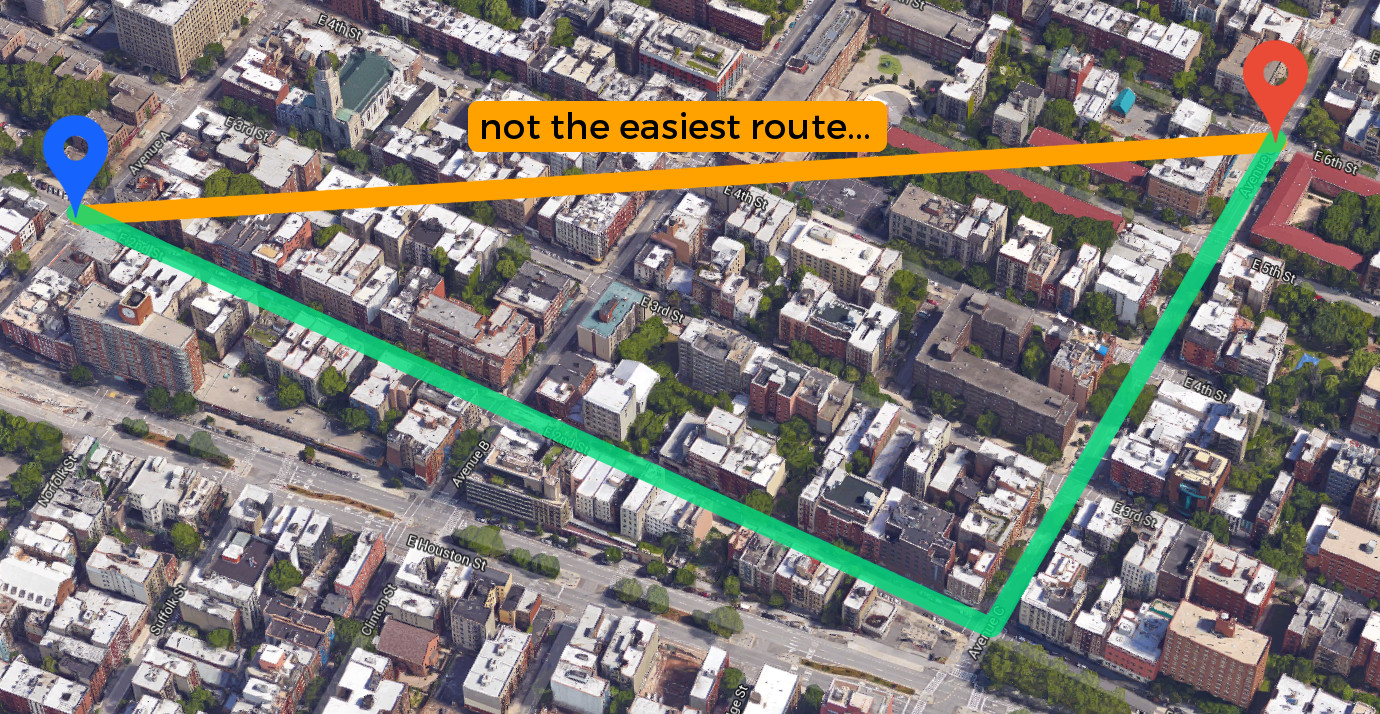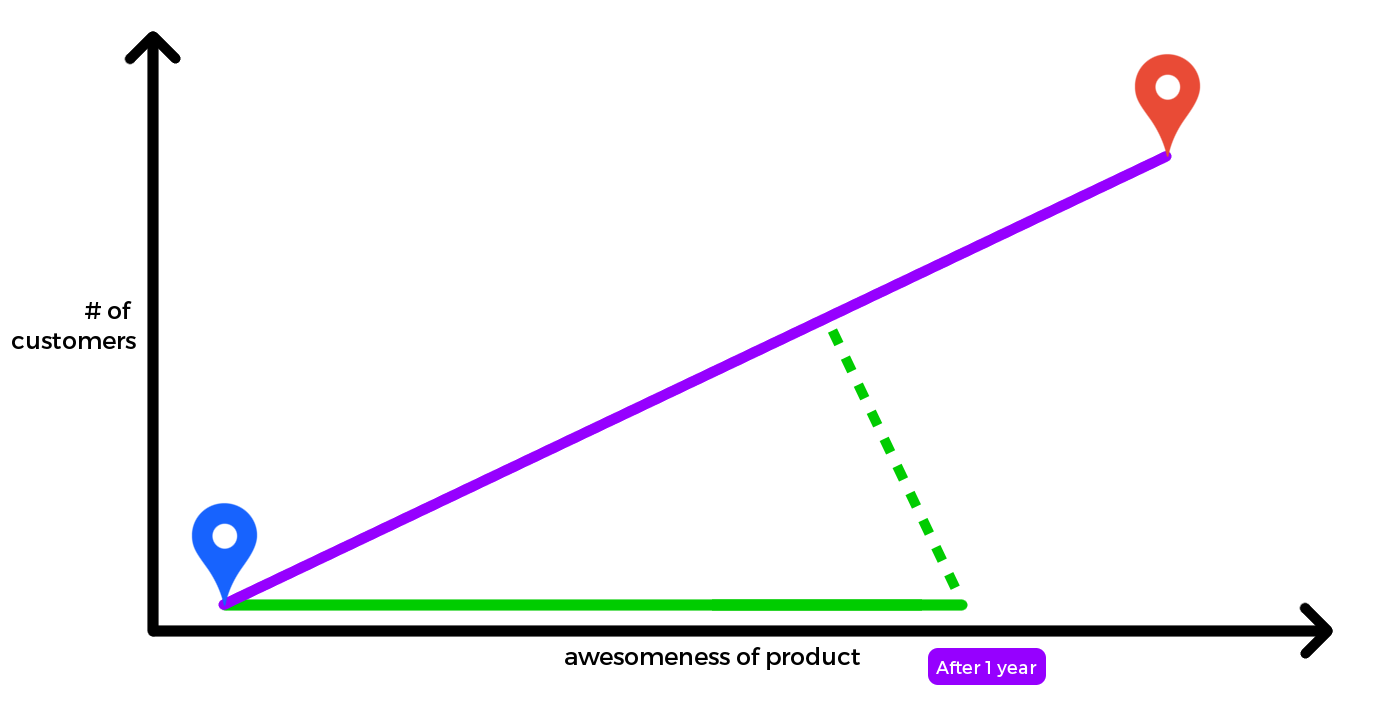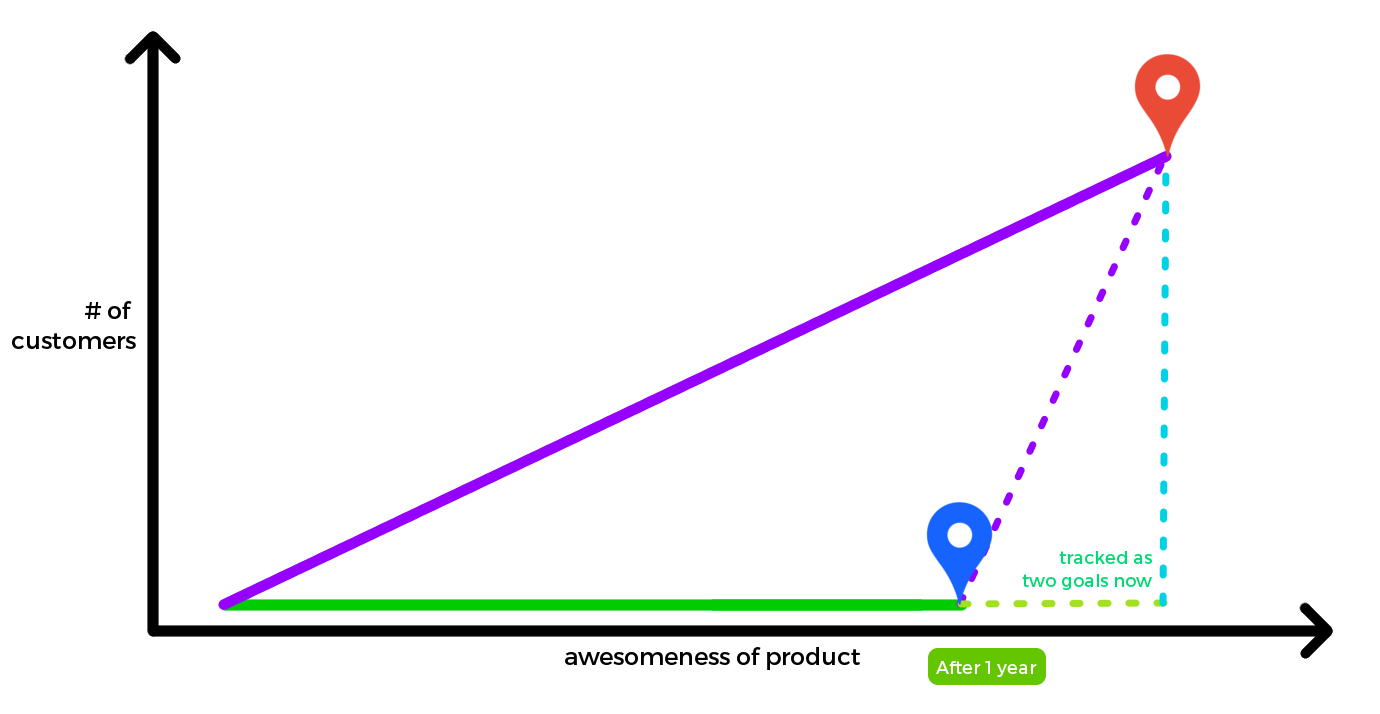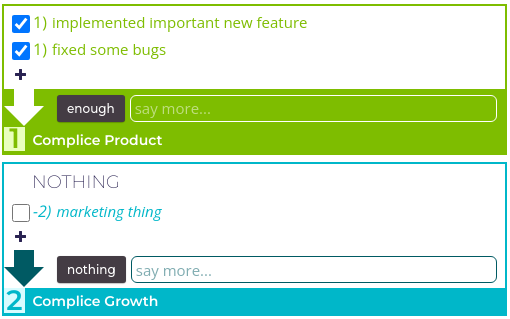(This article was written back when Intend was called Complice, and hasn't yet been updated!)
Since Complice is based on tracking progress towards goals, new Complice users often ask me how to think about their goals. Do they all need to be “S.M.A.R.T.” goals? (“specific, measurable, actionable, relevant, timely”) As in, do they all need to be a specific number, achieved by a specific date?
I think it helps to have goals like that. It helps you be really clear with what you’re aiming for, and to answer the “was today enough?” question. But your goals don’t have to be like that.
Another way to think of your goals is as dimensions. You have where you are, and you have where you want to be (roughly), and your goals can describe the directions you’ll need to travel in order to get to where you want to be.
One way to do this is to just have on direction: draw a straight line between where you are and where you’re going, and say “that’s my goal!” After all, that’s the shortest line, so it should be the easiest route. But I can use a very simple, practical example to demonstrate that that won’t always work. Say you’re downtown in a city with very regular blocks—let’s pick NYC because it has intuitive street names. You want to get from the intersection of 2nd St and Avenue A, to 6th St and Ave C. Now, the line that goes directly between those is the “shortest line”, but it’s not the easiest route—it goes through a bunch of buildings.

You’d be much better off if you broke your goal into two parts “I need to travel between streets going up in number (until 6th)” and “I need to travel between lettered avenues (until C)”. Now your path is really easy, because there are literally roads for you the whole way.
If you envision your life, and the state of the world, a year from now, it might make sense to describe that state all at once. But if you’re trying to get yourself to work towards it, some avenues are going to be much more tractable than others.
How this model applies to more nuanced goals
I think people kind of implicitly think of goals as dimensions a fair bit anyway. I know I did before I realized it. This led me into an interesting kind of mistake, where I was doing a lot of work towards my “Complice” goal, but I wasn’t actually on track to end up where I wanted to be! How did that happen? Well, what was my end goal: my end goal was that Complice was an amazing product, and a profitable business. But I was tracking it as just one goal.

I found myself much more drawn to improving the product than trying to get more customers, so after I got an initial 10 customers, my progress for the next year was basically the green line. Clearly I wasn’t on track towards my goal (the red marker). But since I was only asking “how far along am I along this path?” (the purple line, in the diagram) I could project my progress on improving the product onto that one dimension (the dotted green line), and then it totally looked like I was making lots of progress towards that goal, when I was actually going to end up way over to the right, with an awesome product that nobody was using.
…and broke.

The reason this happened is that even though I knew that I wanted to get more users, it was much easier to to improve the product (both in terms of “I knew how to do it” and “it was really easy to tell what worked and what didn’t”). And so I did what was easy and counted that. I don’t blame my daily decisions for that. I think it was a natural response to how I was incentivizing myself.
So what I did (about a year in) was I broke the Complice goal into two goals: Complice Product and Complice Marketing, and started tracking them separately.

Now it wasn’t enough to have made progress on the product. I needed to also make progress in the marketing dimension somehow. I think that this decision was utterly critical towards me being able to grow the number of paying customers 10× since then. It had its own issues; the marketing goal became a place where I started tracking customer support, and I wasn’t always clear on what I was trying to do. But it helped a lot, because now it was really clear when I was only moving rightwards, not upwards:

I recently went one further and branched off a Complice Onboarding goal, designed to cause me to focus on a lot of the low-hanging fruit for improving the new user experience. This goal seems to have increased the conversion rate substantially… I wish I’d done it much sooner.
So break down goals sometimes
So it seems that it may make sense to have multiple goals for one facet of your life, especially if
- that facet represents a fairly large fraction of your life
- by default you’re liking to focus on one part of it much more than others
- taking action on one part won’t predictably cause other parts to progress
I think this is an interesting point, because several times people have said that Complice doesn’t make sense for them because they’re only really working on one thing at the moment. The goals-as-dimensions model suggests that for some people/things, it might be worth breaking that one thing into 2-3 pieces so that you make consistent progress on all parts of it. And then also, of course, even if you only have one project, we might expect that there are other dimensions that you might like to be moving on:
- physical health / fitness
- closeness of relationships
- habits / routines
- introspection / journalling / personal growth
Other uses for the dimensions model?
You can also use this model to consider task density: how much of your week do you want to be spending doing various activities? This number will depend in part on what you want to achieve and how soon… or, put another way, how fast you want to be moving along each dimension.
Thinking of your goals as dimensions, not as places-to-reach, can be helpful for some people who struggle with fear of failure. For some, it can be psychologically challenging to be facing a goal that you might fail to “achieve”. Having it be a dimension still allows you to keep your life in balance, but it’s now more about the journey than the destination.
Again, it can also be really motivating for other people (or the same people but in different contexts) to have a specific target with a specific date. So experiment and find out what kind of framings work for you!
One related concept you might find useful is lead/lag measures, which are about how sometimes the best way to optimize for one thing (e.g. revenue) is to focus on making a different value go up (e.g. sales calls). Another example would be weight and exercise/diet.
